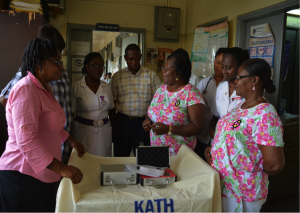Improving Jaundice detection at Komfo Anokye Teaching Hospital
Nearly 50 per cent of all newborns develop a yellowing of skin and eyes known as jaundice. Newborn jaundice can occur when babies have a high level of a yellow pigment bilirubin produced during the normal breakdown of red blood cells. The high levels of bilirubin are due to the inability of the still- developing liver of the newborn to remove bilirubin.
In most cases the jaundice goes away on its own however the high levels of bilirubin can put a baby at risk for deafness, cerebral palsy or other forms of brain damage and ultimately death. The irreparable damage that can be caused by jaundice in the newborn therefore makes it important that all cases of jaundice are immediately detected and addressed by health providers. The levels of bilirubin can be detected through the skin or blood sample.
In Kumasi, jaundice in the newborn is responsible for the admission of up to one in every five babies at the two low-resource neonatal units and the Komfo Anokye Teaching Hospital (KATH) Mother-Baby-Unit Kumasi.
In KATH, the absence of the means of testing for levels of bilirubin in the unit, babies who show up with jaundice have to be admitted for tests. Mothers of babies admitted with jaundice have to pay between $6 and $8 USD to have the test performed in a laboratory to help doctors determine and confirm the treatment for the jaundiced baby. Laboratory tests typically have a turnaround time of 36 hours with the earliest being 24 hours for mothers who are able to afford it. Delay in early assessment of bilirubin levels due to mothers ability to pay for the test can result in situations where babies who could have been sent home are kept on the already overcrowded unit .
Women’s Health to Wealth (WHW) has been working with KATH to improve neonatal health outcomes. After a careful consideration of the costs of the existing situation in the current diagnosis of jaundice in the MBU decided to acquire some Transcutaneous Bilimeters (TCB)to facilitate the detection and treatment of neonatal jaundice.
With funding support from Women Strong International, a consortium of which WHW is a member, four pieces of TCB were purchased to facilitate the detection and assist in the timely management of neonatal jaundice.

Two pieces of the TCB were donated by WHW to the KATH MBU in June 2015. The equipment was received by the head of the unit, Dr. Gyikua Plange–Rhule in the company of her colleague and administrators. In her acceptance speech, she stressed on the speed of diagnosis and ultimately the efficiency that the equipment would bring to the treatment of sick babies and the unit. She also emphasized the budget relief that the equipment would bring to both mothers and the unit as the TCB can diagnose 500 patients at virtually the cost of 2 AA batteries. Her major concern was with the fragile nature of the black tip cover and the need for users to handle the equipment with care.
On her part, Nana Abenaa Akuamoa-Boateng the executive director of WHW thanked them for the opportunity to make a difference in the care of newborns with the provision of the diagnostic equipment. She however implored them to ensure that the usefulness of the tool is not hampered by the inability to replace the batteries that will cost the department less than $2 a month.
The two low resource MBU at the Kumasi South and Suntreso Hospitals in Kumasi have also been given one TCB each.
WHW wishes to appeal to well meaning individuals interested in donating TCBs to the remaining 35 district facility level hospitals in Ashanti to contact us.

